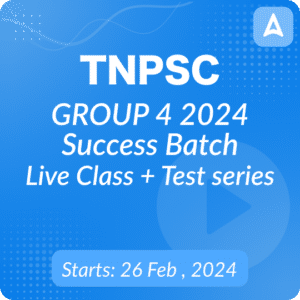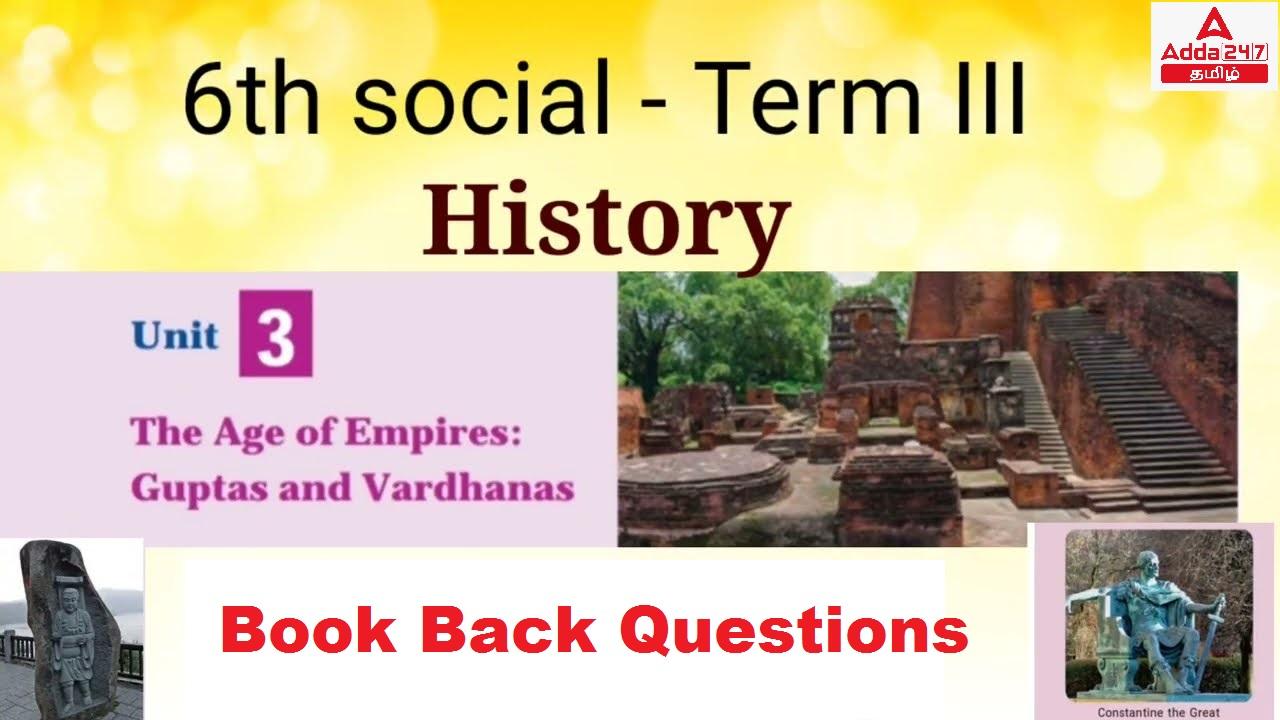TNPSC Samacheer Book Back Questions: ADDA 247 Tamil is giving you TNPSC Samacheer Book Back Questions – The Age of Empires: Guptas and Vardhanas MCQs for all competitive exams. Here you get Multiple Book Back Choice Questions and Answers. Here you will find all the important questions and answers that will help you increase your knowledge and move you toward fulfilling your goals. Study these TNPSC Book Back Questions MCQs and succeed in the exams.
Attend TNPSC Book Back Question Quiz Here
Choose the correct answer
Q1. __________ was the founder of the Gupta dynasty.
(a) Chandragupta I
(b) Sri Gupta
(c) Vishnu Gopa
(d) Vishnugupta
S1.Ans.(b)
Sol.
- Sri Gupta is considered to be the founder of the Gupta dynasty.
- He was the first Gupta ruler to be featured on coins.
- He was succeeded by his son Ghatotkacha.
- Both are mentioned as Maharajas in inscriptions.
Source: 6th Term III Social Science Page no 31
Q2. Prayog Prashasti was composed by __________
(a) Kalidasa
(b) Amarasimha
(c) Harisena
(d) Dhanvantri
S2.Ans.(c)
Sol.
- Samudragupta, son of Chandragupta I, was the greatest ruler of the dynasty.
- The Prayog Prashasti, composed by Samudragupta’s court poet Harisena was engraved on Allahabad Pillar.
- This Allahabad Pillar inscription is the main source of information for Samudragupta’ reign.
Source: 6th Term III Social Science Page no 31
Q3. The monolithic iron pillar of Chandragupta is at __________
(a) Mehrauli
(b) Bhitari
(c) Gadhva
(d) Mathura
S3.Ans.(a)
Sol.
- The most important evidence of development in metallurgy was the Mehrauli Iron Pillar installed by King Chandragupta in Delhi.
- This monolithic iron pillar has lasted through the centuries without rusting.
- The metals used by them were: iron, gold, copper, tin, lead, brass, bronze, bell- metal,mica,manganese and red chalk.
Source: 6th Term III Social Science Page no 36
Q4. __________ was the first Indian to explain the process of surgery.
(a) Charaka
(b) Sushruta
(c) Dhanvantri
(d) Agnivasa
S4.Ans.(b)
Sol.
- Dhanvantri was a famous scholar in the field of medicine. He was a specialist in Ayurveda.
- Charaka was a medical scientist.
- Susruta was the first Indian to explain the process of surgery.
Source: 6th Term III Social Science Page no 37
Q5. ___________ was the Gauda ruler of Bengal.
(a) Sasanka
(b) Maitraka
(c) Rajavardhana
(d) Pulikesin II
S5.Ans.(a)
Sol.
- Raja of Kanauj, was killed by the Gauda ruler Sasanka of Bengal.
- Sasanka also imprisoned Rajayashri.
Source: 6th Term III Social Science Page no 37
- Match the statement with the reason and tick the appropriate answer
Q6. Assertion (A): Chandragupta I crowned himself as a monarch of a large kingdom after eliminating various small states in Northern India.
Reason (R): Chandragupta I married Kumaradevi of Lichchavi family.
(a) Both A and R are true and R is the correct explanation of A.
(b) Both A and R are correct but R is not correct explanation of A.
(c) A is correct but R is not correct.
(d) A is not correct but R is correct.
S6.Ans.(a)
Sol.
- Chandragupta I married Kumaradevi of the famous and powerful Lichchhavi family. Statement II is correct
- Having gained the support of this family, Chandragupta could eliminate various small states in northern India and crown himself the monarch of a larger kingdom. Statement I is correct
- The gold coins attributed to Chandragupta bear the images of Chandragupta, Kumaradevi and the legend ‘Lichchhavayah’.
Source: 6th Term III Social Science Page no 31
Q7. Statement I: Chandragupta II did not have cordial relationship with the rulers of South India.
Statement II: The divine theory of kingship was practised by the Gupta rulers.
(a) Statement I is wrong but statement II is correct.
(b) Statement II is wrong but statement I is correct.
(c) Both the statements are correct.
(d) Both the statements are wrong.
S7.Ans.(a)
Sol.
- Chandragupta II was the son of Samudragupta.
- He was also known as Vikramaditya.
- He conquered western Malwa and Gujarat by defeating the Saka rulers.
- He maintained a friendly relationship with the rulers of southern India.
- The iron pillar near Qutub Minar is believed to have been built by Vikramaditya.
Gupta Polity:
- The divine theory of kingship (the concept that king is the representative of God on earth and so he is answerable only to God and not to anyone else) was practised by the Gupta rulers.
Source: 6th Term III Social Science Page no 33 & 32
Q8. Which of the following is arranged in chronological order?
(a) Srigupta – Chandragupta I – Samudragupta – Vikramaditya
(b) Chandragupta I – Vikramaditya – Srigupta – Samudragupta
(c) Srigupta – Samudragupta – Vikramaditya -Chandragupta I
(d) Vikramaditya – Srigupta – Samudragupta – Chandragupta I
S8.Ans.(a)
Sol.
-
- Sri Gupta is considered to be the founder of the Gupta dynasty.
- Chandragupta I (319–335 AD(CE))
- Samudragupta (335–380 AD(CE))
Chandragupta II (380 – 415 AD(CE))
- Chandragupta II was the son of Samudragupta. He was also known as Vikramaditya.
Q9. Consider the following statements and find out which of the following statement(s) is / are correct
1.Lending money at a high rate of interest was practised.
2.Pottery and mining were the most flourishing industries.
(a) 1. is correct
(b) 2. is correct
(c) Both 1 and 2 are correct
(d) Both 1 and 2 are wrong
S9.Ans.(a)
Sol.
- Lending money at a high rate of interest was in practice during the Gupta period.
- Mining and metallurgy were the most flourishing industries during the Gupta period.
Source: 6th Term III Social Science Page no 35 & 36
Circle the odd one
1.Kalidasa, Harisena, Samudragupta, Charaka.
2.Ratnavali, Harshacharita, Nagananda, Priyadharshika.
III. Fill in the blanks:
- __________, the king of Ceylon, was a contemporary of Samudragupta. (Sri Meghavarman)
- Buddhist monk from China __________, visited India during the reign of Chandragupta II.(Fahien)
- __________ invasion led to the downfall of Gupta Empire.(Huns)
- __________ was the main revenue to the Government. (Land tax)
- The official language of the Guptas was ___ .(Sanskrit)
- __________, the Pallava king was defeated by Samudragupta. (Vishnugopa)
- __________ was the popular king of the Vardhana dynasty. (Harshavardhana)
- Harsha shifted his capital from ___________ to Kanauj. (Thaneswar)
- State whether True or False:
- Dhanvantri was a famous scholar in the field of medicine. (True)
- The structural temples built during the Gupta period resemble the Indo-Aryan style. (False)
- Sati was not in practice in the Gupta Empire. (False)
- Harsha belonged to the Hinayana school of thought. (False)
- Harsha was noted for his religious intolerance.(False)
V.
Q10.Match the following:
- Mihirakula 1.Astronomy
- Aryabhatta 2.Kumaragupta
- Painting 3.Skandagupta
- Nalanda University 4.Caravan trader
- Sartavaga 5.Bagh
(a) 1, 2, 4, 3, 5
(b) 2, 4, 1, 3, 5
(c) 3, 1, 5, 2, 4
(d) 3, 2, 1, 4, 5
S10.Ans.(c)
Sol.
- Aryabhatta, Varahamihira and Brahmagupta were foremost astronomers and mathematicians of the time.
- Aryabhatta, in his book Surya Siddhanta, explained the true causes of solar and lunar eclipses.
- He was the first Indian astronomer to declare that the earth revolves around its own axis.
- The most important examples of the Gupta paintings are found on the Fresco of the Ajanta caves and the Bagh cave in Gwalior.
- Sarthavaha traders were caravan traders who carried their goods to different places.
Q11.Match the following:
- Bana 1.10,000 students
- Harsha 2.Prayag
- Nalanda University 3.Harshacharita
- Hiuen -Tsang 4.Ratnavali
- Buddhist Assembly 5.Si-Yu-Ki
(a) 4, 3, 2, 1, 5
(b) 5, 2, 1, 3, 4
(c) 3, 5, 1, 2, 4
(d) 2, 1, 3, 4, 5
S11.Ans.(c)
Sol.
- Bana’s – Harshacharita
- The Nalanda University, a university and monastery combined, was said to have had 10,000 students and monks in residence, when Hiuen Tsang visited the university.
**************************************************************************

| Adda247 TamilNadu Home page | Click here |
| Official Website=Adda247 | Click here |



